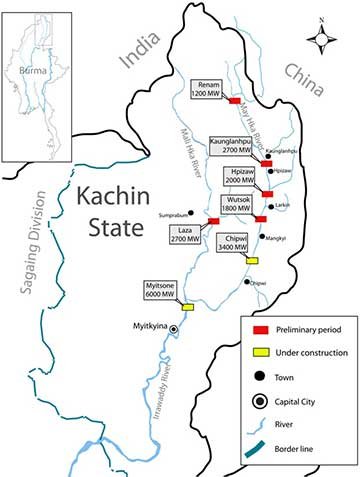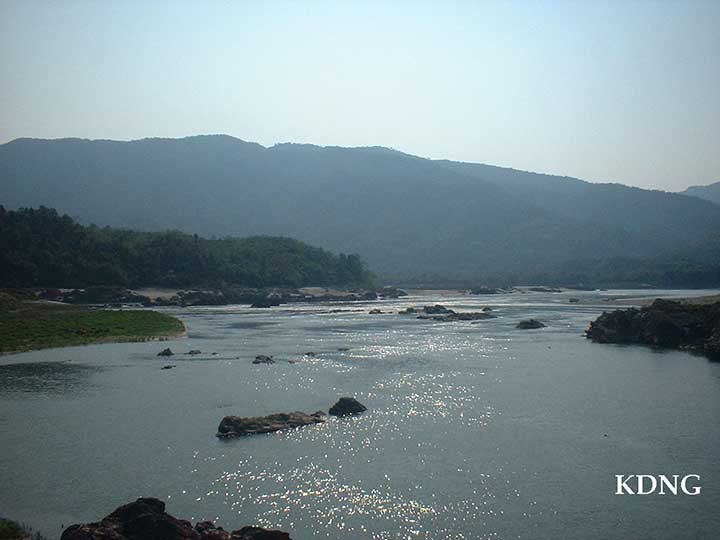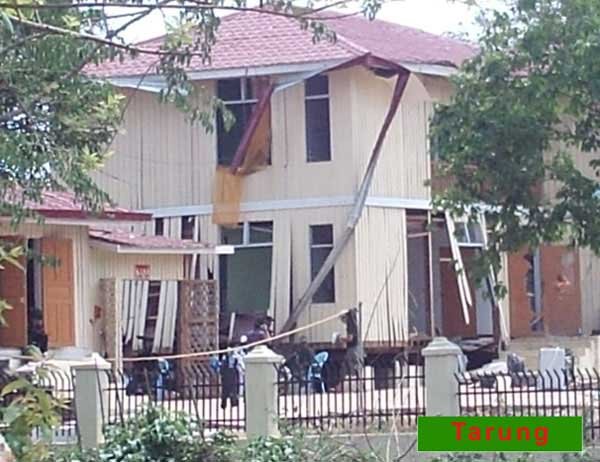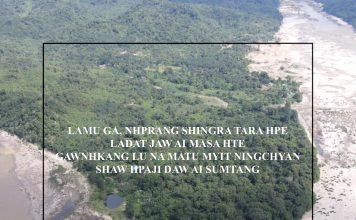
The Irrawaddy River is the lifeline of Burma. Running through the center of the country, millions depend on it for agriculture, fishing, and transportation. The ruling regime, without consulting local people, is now allowing Chinese companies (link to Chinese investor page on BRN website?) to build seven mega dams on the Irrawaddy and its tributaries in Kachin State. The seven dams will produce 17,160 megawatts of electricity, five times more than the current installed capacity for the entire country.
Yet electricity generated by the 152-foot tall Irrawaddy Myitsone dam (6,000 MW), is slated to be sold to China (link to China hydropower magazine article which says electricity will go to China), not used in Burma where there are chronic energy shortages. The sale will provide millions of dollars in revenue to Burma’s regime which has consistently used foreign revenues to build up its military at the expense of health and education, leaving the country with some of the worst social indicators in the world.
The Irrawaddy Myitsone Dam is located on the mainstream Irrawaddy, three miles downstream of the famous confluence of the N’Mai and Mali rivers in Kachin State. The confluence is a revered landmark for all of Burma and particularly important cultural site for the Kachin people and will be submerged by the dam.
The dams are also located in a conflict zone where tension between the armed Kachin Independence Organization (KIO) and Burma’s Army is rising. In March 2011 the KIO wrote to the Chairman of People’s Republic of China (link to letter) warning that it will not be responsible if civil war breaks out when Burmese troops enter KIO-controlled areas to provide security for dam construction.
COMPANIES INVOLVED
While China Power Investment Corporation is the Project Manager of the “Confluence Region Hydropower Projects,” several companies have been or are currently involved in the preparation, construction and financing of the 6,000 MW Irrawaddy Myitsone Dam. Asia World Company, run by Burmese drug-lord Lo Hsing Han, has a key player in facilitating the project.
Burmese
Asia World Company
State-run Myanmar Electrical Power Enterprise
Suntac Technologies
Chinese
China Power Investment Corporation (CPI)
China Southern Power Grid Co. (CSG)
Sinohydro
Yunnan Machinery Equipment Import & Export Company Limited (YMEC) (now UREC)
Changjiang Institute of Surveying, Planning, Design and Research (CISPDR)
Japanese
Kansai Electric Power Company, Incorporated (KEPCO)
CONCERN

Social Concerns:
- Over 60 villages, approximately 15,000 people, will be forcibly relocated without informed consent for the Myitsone Dam alone. Families from six villages have already been forced to move and are currently suffering in a relocation camp. This dislocation will continue to fuel social problems including conflicts over jobs and land, and an increase in migration and trafficking to neighboring countries. Women will be particularly impacted. (flood zone map)
Increasing conflict and security concerns:
-
The dams are located in an area with a long history of conflict that remains unstable. An outbreak of fighting would put local people, the project, and Chinese personnel at risk. In April 2010 a series of at least 10 separate bombs exploded at the Myitsone Dam construction site, injuring a Chinese worker and destroying several temporary buildings and vehicles.
- Increased militarization around the project sites has restricted movement and livelihoods and will lead to further threats to human security. It is well-documented that development projects in Burma are accompanied by increased militarization and human rights abuses, including forced labor and rape.
-
The lack of local benefits and the disregard for local concerns is contributing to resentment and ethnic tension, thereby increasing the likelihood of further violence which may affect Chinese personnel and company assets.
Economic Concerns:
-
The Irrawaddy River provides vital nutrients to wetlands and floodplain areas downstream including the delta region which provides nearly 60% of Burma’s rice. Changes to the river’s flow and the blocking of crucial sediments will affect millions farmers throughout Burma and decrease rice production. (photo of delta rice paddies)
-
Downstream fisheries will be decreased due to the block of fish migration routes and sediment flows and changes in the river’s natural cycles.
-
The dams will create unpredictable water fluctuations and shortages which will disrupt downstream transportation and fisheries.
-
At times when fresh water flows are restricted according to electricity generation needs and during reservoir filling, reduced water levels will increase sea water intrusion into the farmlands of the Irrawaddy delta.
-
Farms and forests upstream will be flooded in a reservoir at least the size of New York City.
Safety Concerns:
-
There are no safeguards to ensure that the dam operators will prioritize the safety of local communities over electricity demands in China when releasing water from the dam; sudden water surges cause boating accidents and drowning.
-
The dam is located 100 kilometers from a major fault line in an earthquake-prone area; if the dam breaks, it will flood Kachin State’s capital city of 150,000 that lies just 40 kilometers downstream of the dam.
- Mercury from mining operations in and along the rivers will accumulate behind the dams and transform to more toxic methyl-mercury which will then be released downstream, increasing the incidence of diseases and birth defects.
Environment Concerns:
- The dams will flood forests upstream in one of the world’s “hottest hotspots” of biodiversity, threatening hundreds of animal and plant species, many of which are endemic or endangered. (could add more about this once EIA is public or link to EIA)
- The dams will impact downstream riverine ecosystems that are home to the endangered Irrawaddy Dolphin.
-
The dams will forever change Burma’s main river ecosystem and an important Asian river. 84% of the Irrawaddy River’s water originates above the dam sites and will be affected by these dams.
-
Extensive and environmentally destructive gold mining as well as logging have already begun along the banks of the N’Mai and Mali rivers and upstream of the dam sites.
Process Concerns:
- State-owned China Power Investment Corporation (CPI) is not following Chinese or international dam-building standards or the recommendations of its own preliminary Environmental Impact Assessment. (link to EIA)
- No environmental, social or health impact assessments of the dams have been publicly disclosed
- Locally-affected residents have not been consulted about the projects; their attempts to voice concerns (link to appeals page or community action section) have been ignored.
- A flawed compensation and resettlement process that has no independent oversight or accountability mechanisms is being carried out using intimidation by military authorities.
-
The majority of electricity generated by the dams will be exported to China. Based on the experience of other hydropower projects in Burma, any remaining power will be used by the Burma Army and associate military businesses and will not be available or affordable to local people.
- The sale of electricity from the Myitsone Dam alone could earn the military regime over US $500 million per year and foreign direct investment income of an estimated US $3.6 billion. There is no transparency in how revenues will be spent.


- Despite the risks of arrest, torture or death for dissent in military-ruled Burma, brave people are voicing their concerns and demanding a halt to the dams. Various community leaders and villagers have sent numerous appeal letters to Burma’s military government and the Chinese government. (link to appeal letters page)Mass prayer ceremonies calling for the protection of the rivers have been held along the river’s banks and in churches up and downstream.
In a face-to-face meeting with the Burma Army’s Northern Commander, local women made it clear that no amount of compensation will make up for the losses these dams will bring to their community and future generations.(video box or link here) Posters, leaflets and graffiti against the dam have been posted and distributed in cities in Kachin State. (photo of graffiti)
Downstream, artists and writers from across the country have organized tours and art exhibitions to highlight the importance of the Irrawaddy for all of Burma. Overseas Kachin communities have sent letters to the Embassy of China in seven countries and held demonstrations in New Delhi and London.
In order to protect the health of the Irrawaddy upon which millions in Burma depend, the dams in Kachin State must be stopped. We KDNG urge China Power Investment Corporation (CPI) to immediately stop construction of the Myitsone Dam and other dams in Kachin State and pull out from investment with Burma’s regime for the sake of the good image of its company and to avoid being complicit in multiple serious abuses associated with the project.
Rural communities in Burma and Kachin State are utilizing the appropriate technology of small hydropower to realize their electricity needs on their own. The Kachin capital of Myitkyina is one of the few cities in Burma that currently receives 24-hour electricity due to an existing small hydropower project. The concept of decentralized management and the right of local people to manage and utilize the electricity generated by small hydro needs to be promoted in Burma.
Small hydro Explanation –
Small hydropower (SHP) can be tapped from small streams, medium and large rivers. It is an environmentally-friendly source of energy generation. SHP, defined most frequently as generating less than 10 MW of power, has very little negative impact and can provide needed power to remote locations.
In small hydro systems, water is diverted through a channel to a turbine where it strikes the bucket of a wheel, causing the turbine to rotate. The rotating shaft is connected to a generator which converts the motion into electrical energy. They require no large dams or reservoirs and thus no displacement or submergence of forests and farm fields.







